As an Amazon Associate KitchenwareSets.com earns from qualifying purchases.
Dining Table in Kitchen Smart Layout Ideas for Small Spaces
Do you dream of sipping coffee at a proper kitchen table but feel trapped by your limited square footage? It’s a common frustration: wanting the convenience and charm of an eat-in kitchen but facing the reality of a space that feels too cramped, cluttered, or inefficient to accommodate one. The bulky footprint of a traditional dining table seems like an impossible puzzle piece to fit into an already crowded room.
You picture a central hub for family meals, a spot for kids to do homework while you cook, or simply a civilized place to eat that isn’t the sofa. Yet, the fear of sacrificing precious counter space or creating an impossible-to-navigate obstacle course holds you back. You’re left wondering if a functional and beautiful kitchen dining area is a luxury reserved only for those with larger homes.
The great news is that a dining table is absolutely possible in a small kitchen by using space-saving furniture and clever layouts. The key is to choose smart pieces like round tables, versatile drop-leaf tables, or cozy built-in banquettes that maximize both your floor space and functionality without adding clutter. With the right strategy, you can transform your small kitchen into the inviting heart of your home.
https://www.pinterest.com/pin/modern-kitchen-and-dining-area-design-combining-functionality-style-and-quality–492649953901989/
Is a Dining Table in Your Small Kitchen Even Possible?
Yes, a dining table is absolutely possible in a small kitchen by using space-saving furniture like round or extendable tables, built-in banquette seating, and clever layouts. The goal is to maximize both floor space and functionality without creating clutter. As someone who has navigated the challenges of a tiny apartment kitchen, I know the struggle is real. But I’ve also discovered that the right layout can make all the difference.
The dream of an eat-in kitchen often clashes with the reality of limited square footage. A bulky, space-consuming table can quickly turn a functional kitchen into an inefficient, cluttered mess. However, by rethinking the traditional dining setup, you can create a comfortable and practical dining spot. This guide is updated for 2025 to give you the most current and effective strategies to reclaim your kitchen and make room for the table you’ve always wanted.
Why a Kitchen Dining Area is a Game-Changer
Creating a dining area in your kitchen is a major upgrade to your home’s functionality and feel, turning it into a multi-purpose central hub. Interior design principles emphasize creating efficient living spaces, and an eat-in kitchen is the epitome of this concept. It’s more than just a place to eat; it’s a strategic design choice that enhances daily life.
Here are some of the key benefits:
- Creates a Central Hub: The kitchen naturally draws people in. A table makes it the official gathering spot for casual family meals, morning coffee, and after-school snacks, fostering connection.
- Ultimate Convenience: Serving meals and clearing dishes becomes incredibly simple when the table is just steps away. No more carrying hot plates through doorways or down hallways.
- Multi-Functional Space: Beyond meals, the kitchen table serves as a perfect spot for kids to do homework, for you to sort mail or work on a laptop, or as extra prep space in a pinch.
- Enhances Social Cooking: It allows family and guests to sit and chat with the cook, making meal prep a more inclusive and enjoyable social activity rather than an isolated chore.
- Increases Home Appeal: An eat-in kitchen is a highly desirable feature for many homebuyers, potentially adding to your home’s overall value and appeal.
7 Smart Layout Ideas for Your Kitchen Dining Table
Fitting a dining table into a small kitchen isn’t about magic; it’s about smart, strategic choices. The right layout and furniture can unlock hidden potential in your space, creating a comfortable dining spot without sacrificing workflow. We’ve curated these layout ideas based on top interior design solutions for small spaces and real-world examples that maximize every square inch. From clever furniture that adapts to your needs to layouts that use awkward corners, these seven proven strategies will help you find the perfect fit for your home.
1. Embrace the Curve: The Round Pedestal Table
A round table, especially one with a pedestal base, is a superior choice for a small kitchen because it eliminates sharp corners and bulky legs, improving traffic flow and maximizing seating. The curved shape physically takes up less room and allows you to tuck chairs in more tightly, making the entire setup feel less intrusive.
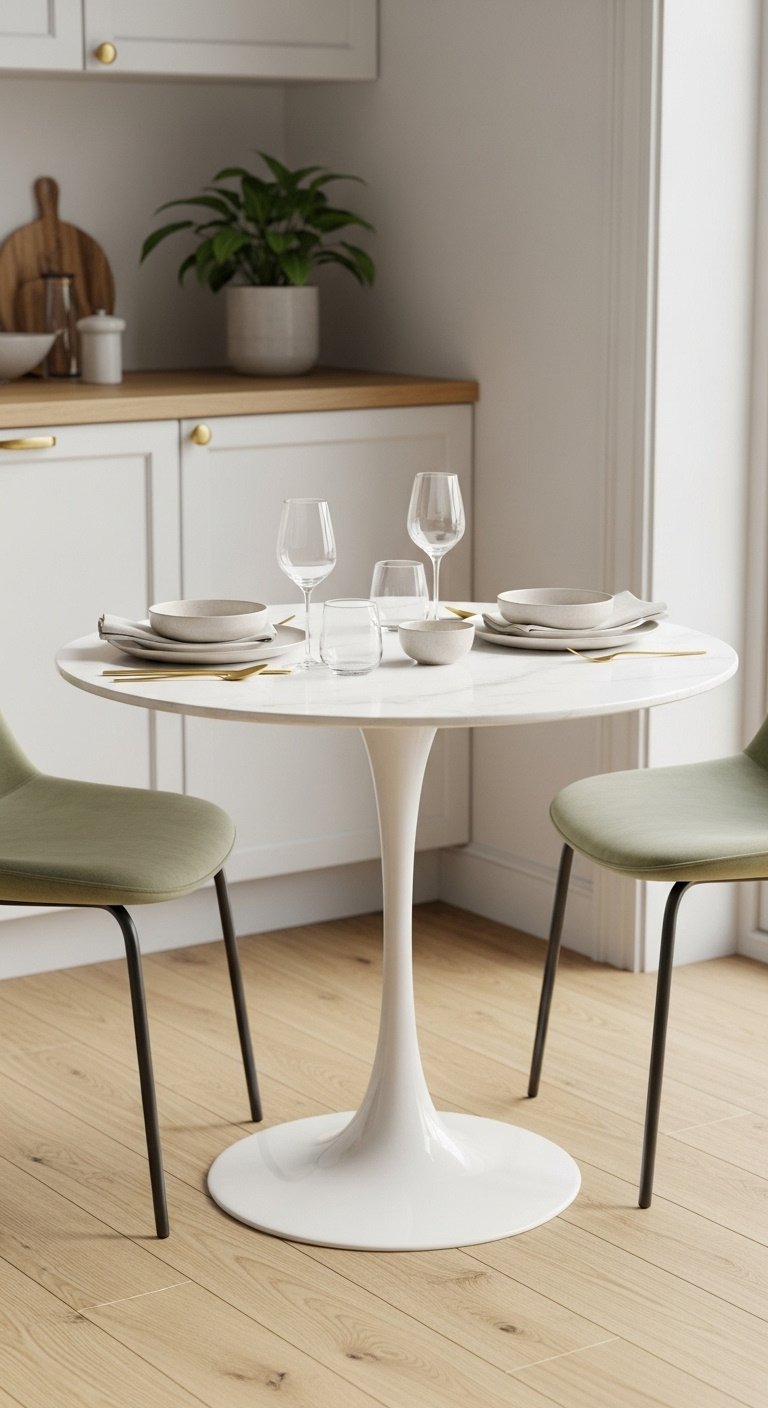
- Materials Needed: Measuring tape, painter’s tape, round pedestal table, slim-profile chairs.
- Step-by-Step Directions:
- Measure your available space. A general rule is to leave 36 inches (or about 90 cm) of clearance around the table for easy movement.
- Use painter’s tape on the floor to outline the diameter of the table you’re considering. This helps you visualize the actual footprint and workflow around it.
- Place the table in the designated area. The single pedestal base eliminates corner legs, which provides more legroom and makes it easier to tuck chairs in completely.
- Arrange chairs around the table. The curved shape allows you to squeeze in an extra guest more comfortably than a square table of a similar size.
Pro-Tip: In a square-shaped kitchen, a round table is particularly effective at softening the hard lines of cabinets and walls, creating a more inviting and organic feel.
Pin this round table idea for your small kitchen inspiration!
2. The Flexible Friend: Extendable & Drop-Leaf Tables
The most flexible solution for a small kitchen is an extendable or drop-leaf table that adapts to your needs, saving space for daily use while expanding to accommodate guests. These versatile pieces can function as a narrow console or a small two-person table most of the time, and then transform into a larger dining surface when required.
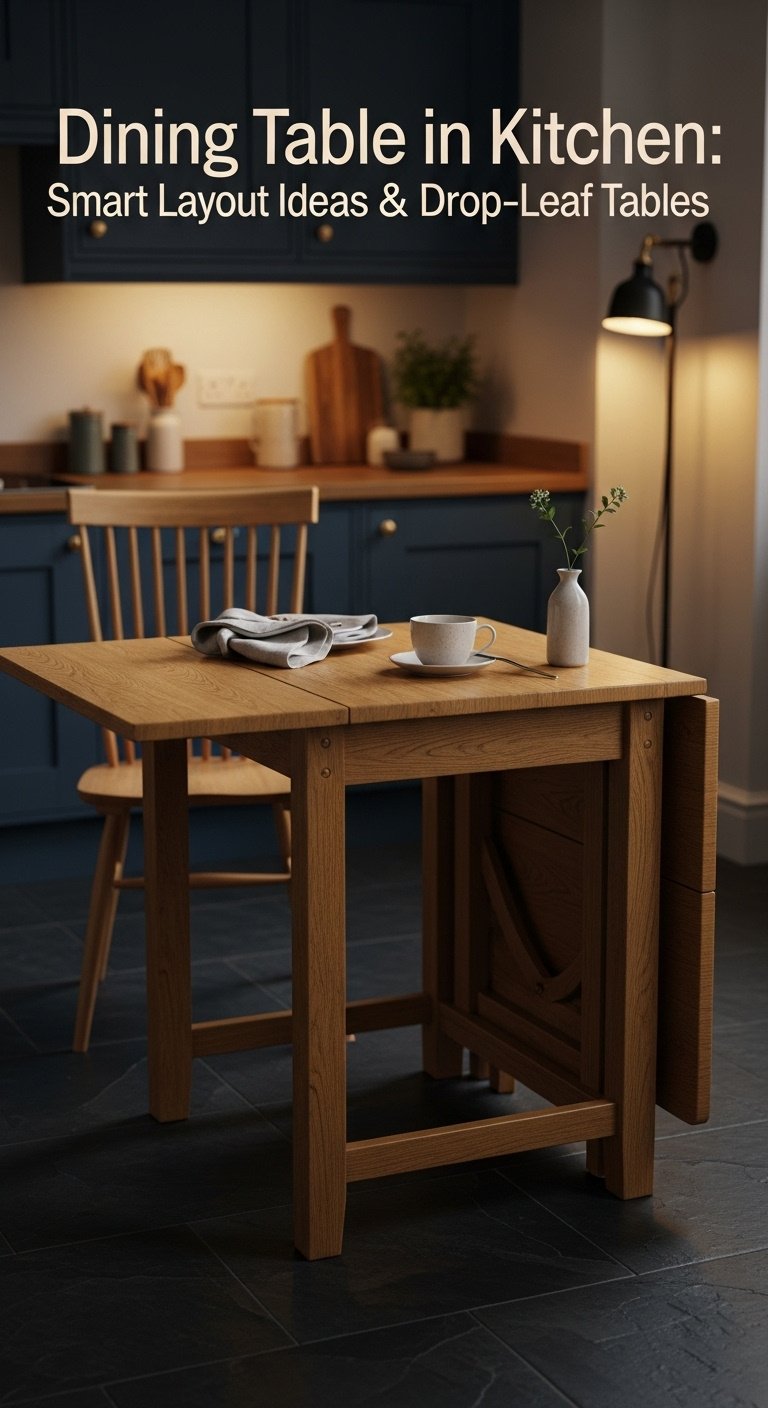
- Materials Needed: An extendable, drop-leaf, or gateleg table.
- Step-by-Step Directions:
- Identify a wall space or area where the table can live in its most compact form, acting as a small breakfast spot or console table.
- For daily use, keep the leaves down or the extension panel hidden to maximize precious kitchen floor space for cooking and moving around.
- When guests arrive, simply pull the table away from the wall, lift the leaves, or insert the extension panel to create a larger dining surface.
- Pair with stackable or folding chairs that can be stored in a closet or on wall hooks and brought out only when needed.
Lesson Learned: Measure your space with the table fully extended before buying. You still need that crucial 36 inches of clearance for chairs and movement, even when it’s at its largest size.
Love flexible furniture? Save this drop-leaf table idea!
3. The Nook Solution: Built-In Banquette Seating
A built-in banquette is one of the most efficient ways to add dining to a small kitchen, as it tucks seating directly into a corner and eliminates the need for chair clearance on two sides. This cozy nook solution not only saves a surprising amount of space but also offers the potential for valuable hidden storage under the benches.
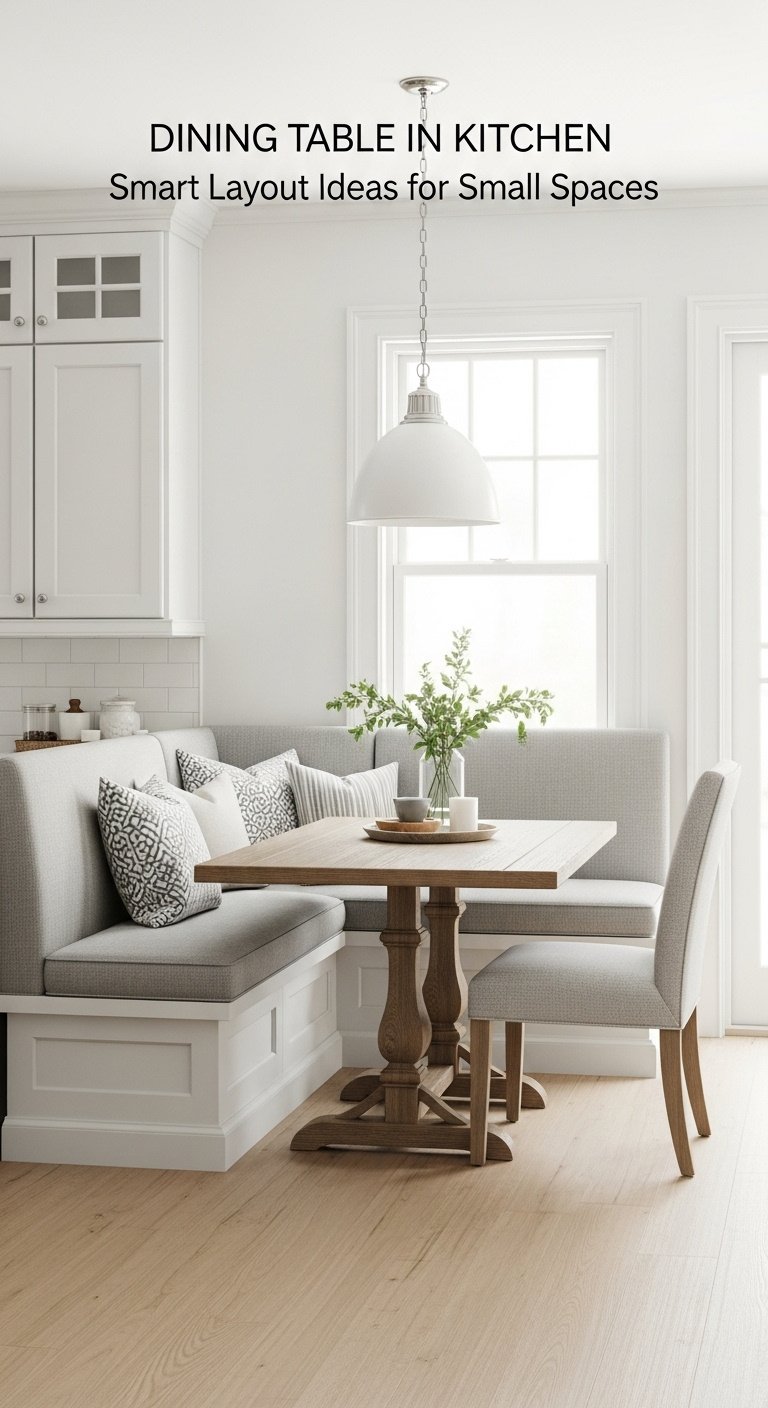
- Materials Needed: L-shaped banquette bench, small rectangular or round table, 1-2 dining chairs.
- Step-by-Step Directions:
- Identify an unused or awkward corner in your kitchen. This layout transforms dead space into a highly functional zone.
- Install an L-shaped banquette bench flush against the walls. For maximum utility, choose a model with lift-top seats to gain hidden storage for kitchen linens, seasonal items, or small appliances.
- Pair the banquette with a pedestal table. This is crucial as it allows for easier sliding in and out without having to navigate around table legs.
- Add one or two lightweight, armless chairs on the open sides of the table to provide flexible seating for guests.
Pro-Tip: A custom-built banquette can be perfectly tailored to your kitchen’s exact dimensions, making it feel like a high-end, integrated feature rather than an afterthought.
Save this cozy banquette idea to your ‘Dream Home’ board!
4. The Linear Layout: Table Against the Wall
For narrow or galley-style kitchens, the most practical layout is placing a slim rectangular table against an open wall, which preserves a clear and unobstructed main traffic path. This simple, linear approach provides dedicated seating for two or three people without compromising the kitchen’s core functionality.
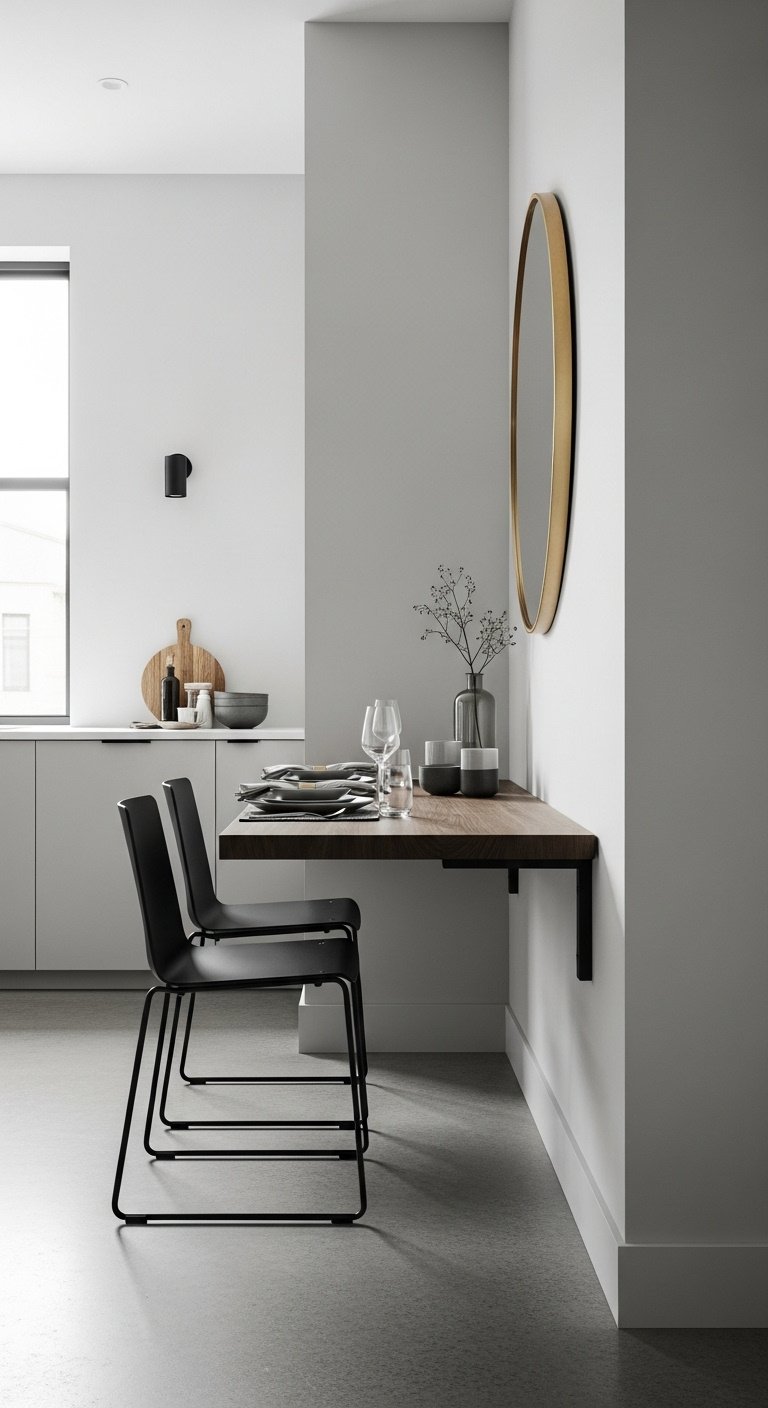
- Materials Needed: A narrow rectangular or square table, two chairs, or one long bench.
- Step-by-Step Directions:
- Select a slim or narrow rectangular table that won’t protrude too far into the room.
- Push one of the long sides of the table directly and firmly against an available wall. This instantly frees up the maximum amount of floor space for walking.
- Place chairs on the open sides. For an even more compact solution, use a single bench that can be tucked completely underneath the table when it’s not in use.
- When you need to seat more people for a special occasion, simply pull the table away from the wall and add chairs to the fourth side.
Pro-Tip: Hang a large mirror or a piece of art on the wall above the table. This defines the dining zone and a mirror, in particular, can create the illusion of a much larger, brighter space.
Pin this space-saving wall layout for your apartment!
5. The Double-Duty Hero: The Island-Table Hybrid
A multi-functional kitchen island that incorporates a dining area is the ultimate double-duty hero, combining food prep space and a casual eating spot into a single, highly efficient footprint. This is an ideal solution for kitchens where there simply isn’t room for both a separate island and a separate dining table.
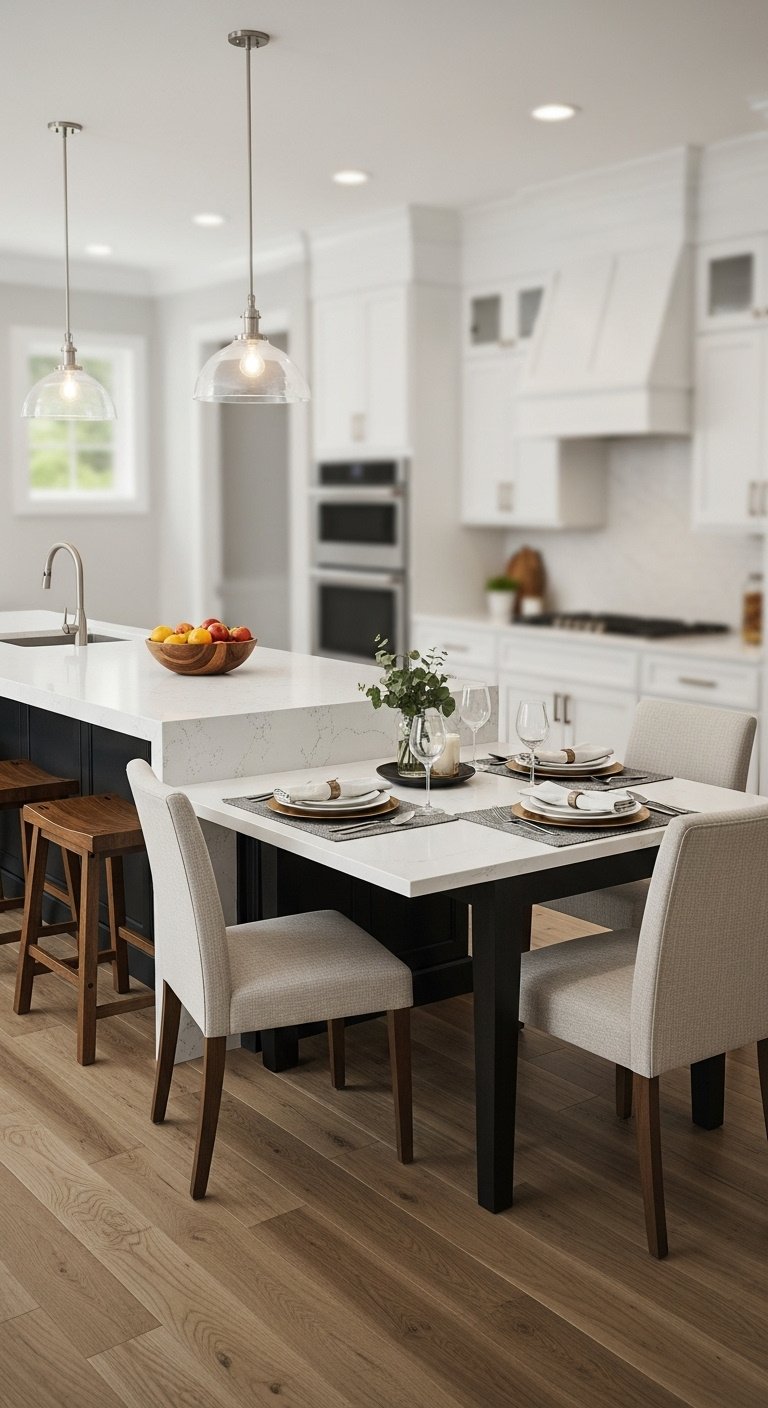
- Materials Needed: A counter-height dining table or a kitchen island with an extended overhang or tiered design.
- Step-by-Step Directions:
- In a kitchen that can’t fit both, consider forgoing a traditional island and using a counter-height dining table (around 36 inches high) in its place. This allows it to comfortably serve as both a prep surface and a dining table.
- Alternatively, choose a kitchen island specifically designed with an extended overhang on one side, creating a breakfast bar where stools can be tucked away.
- For a more distinct separation, look for islands that feature a tiered design, with a standard counter-height work surface and a lower, table-height extension for dining chairs.
- This creates clear zones for cooking and eating within one consolidated piece of furniture.
Pro-Tip: Ensure your island-table has appropriate electrical outlets integrated into the base for using small appliances or charging devices to maximize its utility as a multi-purpose hub.
Need a multi-functional kitchen? Pin this island-table idea!
6. The Optical Illusion: Glass and Acrylic Furniture
You can create the illusion of more space by choosing furniture with low visual weight, such as glass-topped tables and clear acrylic chairs, which appear to take up almost no room. This “ghost” furniture allows light to pass through and keeps sightlines open, preventing the dining set from looking bulky and making the entire kitchen feel larger and less cluttered.

- Materials Needed: A glass-topped dining table, clear acrylic chairs (“ghost chairs”).
- Step-by-Step Directions:
- Choose a dining table with a sturdy glass top. The transparency allows the eye to see the floor underneath, which is a classic design trick for making a space feel more open.
- Pair the table with clear acrylic chairs. Because they are see-through, these chairs have very little visual weight and seem to almost disappear, which is perfect for preventing a small area from feeling crowded.
- This combination is highly effective in very small or visually busy kitchens, as it provides full functionality without adding to the visual noise.
- Keep the surrounding decor simple and light to enhance the airy, spacious effect.
Pro-Tip: While visually stunning, glass and acrylic require more frequent cleaning to look their best. Keep a microfiber cloth and a suitable cleaner handy for quick wipe-downs of fingerprints and smudges.
Make your small space feel huge! Save this clear furniture idea.
7. The Now-You-See-It-Now-You-Don’t: Wall-Mounted Table
For the tiniest of kitchens, the ultimate space-saving solution is a wall-mounted table that folds up and disappears when not in use, freeing up 100% of the floor space. This “Murphy bed” approach to dining provides a stable eating surface when you need it and becomes nearly invisible when you don’t.
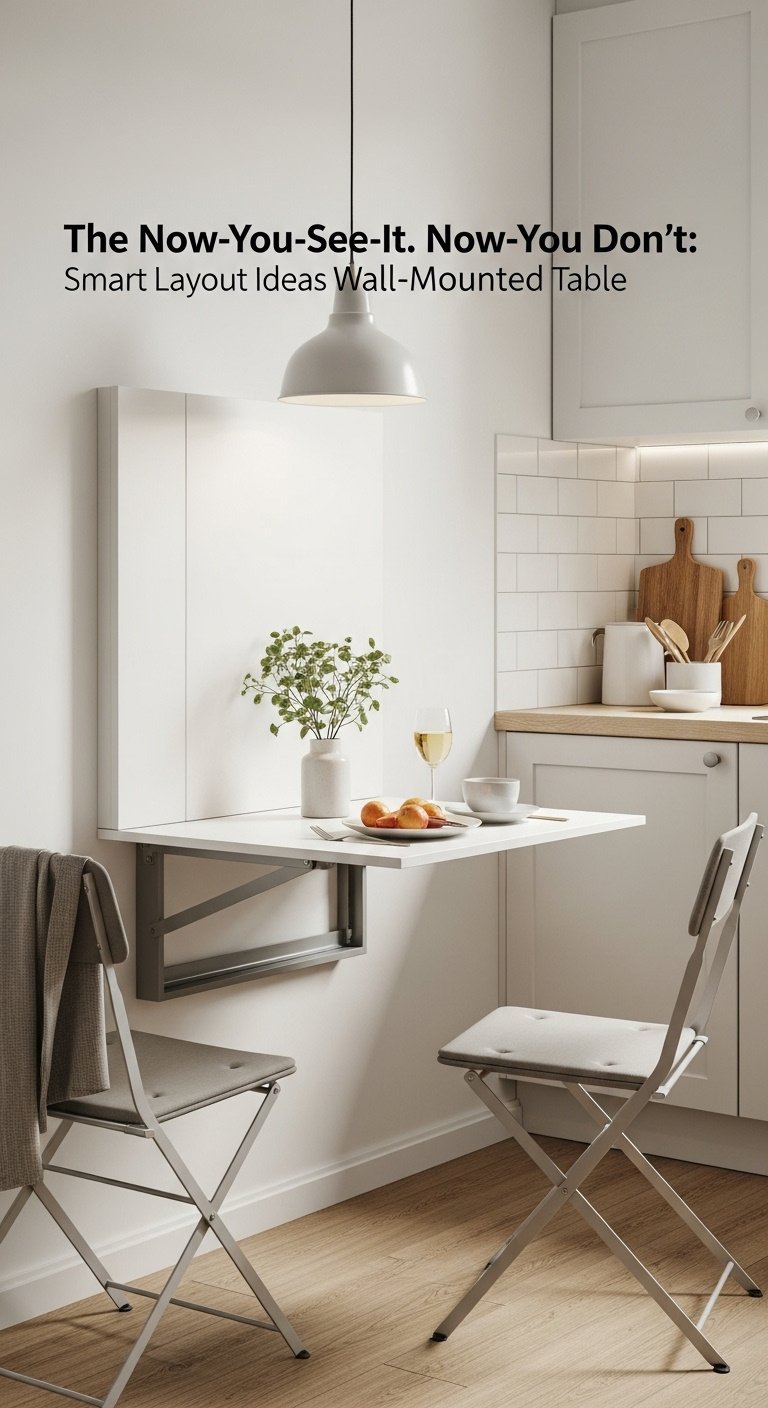
- Materials Needed: A wall-mounted collapsible table kit, folding chairs.
- Step-by-Step Directions:
- Identify a clear stretch of wall in your kitchen that can accommodate the table’s footprint when folded down.
- Install a wall-mounted table that folds down for meals and folds up flat against the wall afterward.
- Many modern designs are multi-functional, revealing a chalkboard, mirror, or shallow shelving when folded up, adding utility even in their closed position.
- Pair this setup with ultra-slim folding chairs that can be hung on stylish wall hooks or slipped into a narrow gap beside the refrigerator.
Lesson Learned: Professional installation is often best for wall-mounted tables to ensure they are securely anchored into the wall studs. This is critical for safety and to guarantee the table can safely bear weight during use.
The ultimate space-saver! Pin this fold-down table idea.
Key Takeaways: Your Quick Guide to a Dining Table in a Small Kitchen
Feeling overwhelmed? Don’t be. Creating the perfect eat-in kitchen comes down to a few core principles. Here’s a quick summary of the most important points to remember:
- Shape Matters: Round or oval tables are better for traffic flow and fitting more people in tight spaces because they lack sharp corners.
- Be Flexible: Extendable, drop-leaf, or wall-mounted tables are your best friends, allowing you to claim back floor space when not dining.
- Use Your Corners: Banquette or bench seating is the most efficient way to use corner space, often adding the bonus of hidden storage.
- Think Vertically & Visually: Use “invisible” furniture like glass or acrylic to reduce visual clutter, and hang mirrors to create an illusion of depth and light.
- Measure for Movement: Always leave at least 36 inches of clearance around your table so people can move and pull out chairs comfortably. This is the golden rule of dining layout.
People Also Ask About Dining Tables in Kitchens
Can you put a dining table in the kitchen?
Yes, you can definitely put a dining table in the kitchen. This popular setup, known as an “eat-in kitchen,” is incredibly convenient. For smaller kitchens, the trick is to choose space-saving furniture like a compact round table, a versatile drop-leaf table, or a custom built-in banquette to ensure the room stays functional and doesn’t feel cramped.
Should the dining table be close to the kitchen?
Ideally, yes, the dining table should be close to the kitchen. This proximity makes serving food and clearing away dishes much more convenient and efficient. In modern open-concept layouts, having the dining area adjacent to the kitchen creates a seamless, natural flow for both daily life and entertaining.
Is there a difference between a kitchen table and a dining table?
Traditionally, kitchen tables were smaller and more casual, built from durable materials for everyday use, while dining tables were larger, more formal pieces for a separate room. However, in today’s homes, the terms are often used interchangeably. With the rise of open layouts and eat-in kitchens, a single table frequently serves both the casual, everyday purpose and the more formal dining function.
Final Thoughts
A small kitchen doesn’t mean you have to sacrifice the simple joy and immense functionality of a dedicated dining space. As you’ve seen, the challenge isn’t about the size of your room, but the creativity of your solution. By choosing the right shape, embracing flexible furniture, and using every corner wisely, your kitchen can become the multi-functional, inviting hub for meals and memories you’ve always wanted.
Which of these layout ideas would work best in your kitchen? Let me know in the comments below
